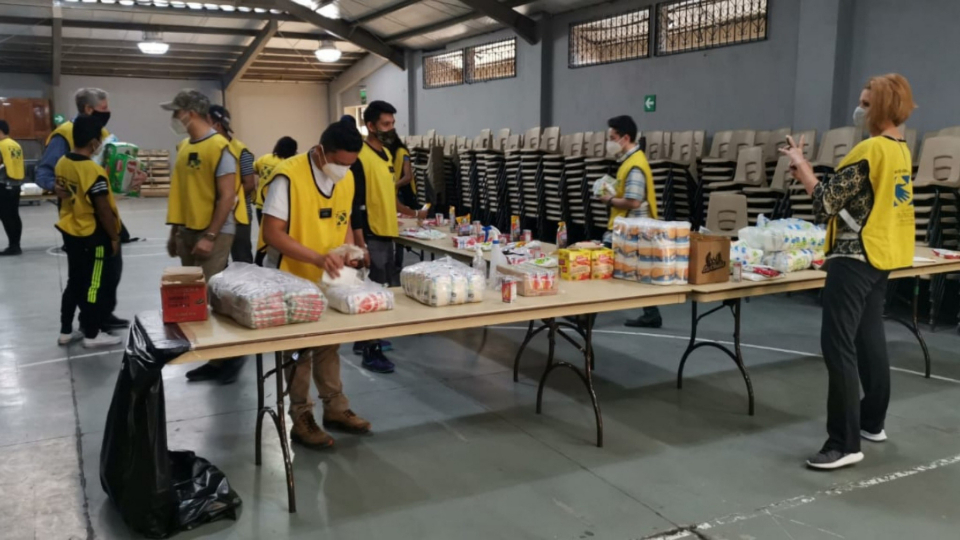Latter-day Saint Charities and members of The Church of Jesus Christ of Latter-day Saints are helping those affected by Hurricanes Eta and Iota. They delivered thousands of emergency supplies and over 120 tons of food to help Central Americans recover from the catastrophic trail of destruction the storm left in its wake after hitting eastern Nicaragua on November 3, 2020.
- A1111YU-HUMA-ETA-GT-7.jpeg
- voluntarios---6AYU-HUMA-ETA-GT-15.jpeg
- RSZDWebp.net-resizeimage.png
- 1-GT.jpeg
- water---8Eta-4.jpg
- 5---eta-coban-12.jpeg
- Webp.net-resizeimage.jpg
| Temple Square is always beautiful in the springtime. Gardeners work to prepare the ground for General Conference. © 2012 Intellectual Reserve, Inc. All rights reserved. | 1 / 2 |
The deadly Category 4 storm, the third most intense November Atlantic hurricane on record, hit several countries, including Nicaragua and Honduras.
Although the 150 mph (240 km/h) storm impacted tens of thousands of Central America’s residents, it failed to deter the Church’s official humanitarian organization and local Church members from extending a helping hand to hurricane survivors in need.
In collaboration with local community and government leaders, Latter-day Saints Charities gathered, transported and distributed the vital humanitarian relief.
“Our unique position of strength is access to thousands of member volunteers within these impacted communities,” said Sharon Eubank, president of Latter-day Saint Charities. “Disaster-relief supplies and funding may come through Latter-day Saint Charities, but that assistance is made possible by the generosity of members of the Church of Jesus Christ and distributed by other member volunteers living in these communities. We are deeply thankful for the critical help they’ve given to serve their communities.”
Thousands of donated items, made possible primarily through the generous contributions of Latter-day Saints, included 120 tons of food, water, face masks, blankets and mattresses.
1-GT.jpeg
Plastic bins with food donations temporarily sit on a warehouse floor in Guatemala City, Guatemala, before being transported to people impacted by Hurricane Eta in November 2020. 2020 by Intellectual Reserve, Inc. All rights reserved.Tools and building materials to help hurricane survivors repair and rebuild their storm-ridden homes were also donated.
Just two weeks after Hurricane Eta pounded Central America, another record-breaking Category 4 hurricane, Hurricane Iota, made landfall approximately 15 miles south of where Hurricane Eta hit the Nicaraguan coast.
Iota was the 30th named storm during 2020, a record for the most named storms in the Atlantic Ocean in a single season. The impact and aftermath of Hurricane Iota is just beginning to be assessed. The storm is blamed for at least 19 deaths.
Even though thousands of residents sought refuge with the news of Hurricane Eta approaching, more than 100 fatalities across Central America have been attributed to the storm.
In addition to its toll on human life, Hurricane Eta’s torrential rain and wind unleashed massive mudslides and fatal flooding and knocked down power lines and trees.
Latter-day Saints in Nicaragua helped gather and donate 80 tons of food, water and hygiene kits for Puerto Cabazas, one of the country’s hardest-hit cities. While floods are slowly decreasing there, several areas are still isolated, which means that residents are too.
“I felt great joy knowing that I could donate the little canned food I had at home because it was going to someone who needed it more,” shared a Latter-day Saint from Tegucigalpa, Honduras, who preferred not to be named.
To help hurricane-ridden Nicaraguan families and individuals repair their homes, wood, nails and zinc roof sheets were also sent to the extensively damaged coastal city. These will be gifted to residents whose homes were damaged by the storm.
Just north of the country in Honduras, storm conditions affected the region similarly with devastating floods. The hurricane damaged hundreds of homes and 10 Church buildings.
In the meantime, eight Church meetinghouses that escaped Hurricane Eta’s wrath were temporarily converted into shelters for survivors who were forced to abandon their homes.
Torrential rain poured for days and caused a major landslide in San Cristóbal, Guatemala. The saturated soil’s weight ultimately ripped down parts of the mountainside in San Cristóbal Verapaz. Dozens of people are believed to have lost their lives or are still missing.
In an effort to provide crucial sustenance to those in need, Latter-day Saint Charities also donated 20 tons of food to survivors in Cobán, Puerto Barrios and Polochic.
Latter-day Saints from Cobán also supported hurricane survivor rescue teams, organized food items and prepared food for people impacted by the storm in Church meetinghouses.
Most of the items were transported thanks to the support of Aeroclub Guatemala, a local aircraft organization. Pilots donated 14 airplane and helicopter flights and their time to move the items to the most remote and highly impacted areas, including Alta Verapaz and Izabal.
“We thank The Church of Jesus Christ of Latter-day Saints for their valuable collaboration during this Eta emergency,” said Jorge Castellanos, Aeroclub Guatemala’s president. “We are eternally grateful.”
In Guatemala City, dozens of socially-distanced missionaries and other volunteers helped pack donations like food, hygiene kits and clothes.

ldsmisioneros-ETA-7.jpg
A group of Latter-day Saint missionaries helps organize food donations and hygiene kits for Hurricane Eta survivors in Guatemala City, Guatemala, on Tuesday, November 10, 2020. 2020 by Intellectual Reserve, Inc. All rights reserved.“Any service event strengthens our love for Christ,” said Elder William B. Woahn. He and his wife, Heidi, participated in the activity and serve as full-time senior missionaries. “Our hearts were filled with joy for the opportunity to serve.”
Other donated items included water, hygiene kits, mattresses and more than 8,000 face masks to help keep the COVID-19 pandemic at bay.
Tools to aid locals with recovery, including shovels, hoes, hoses and wheelbarrows, were quickly delivered and distributed to community members. Local Church leaders expect that more than 11,900 people will benefit from the organized relief efforts.